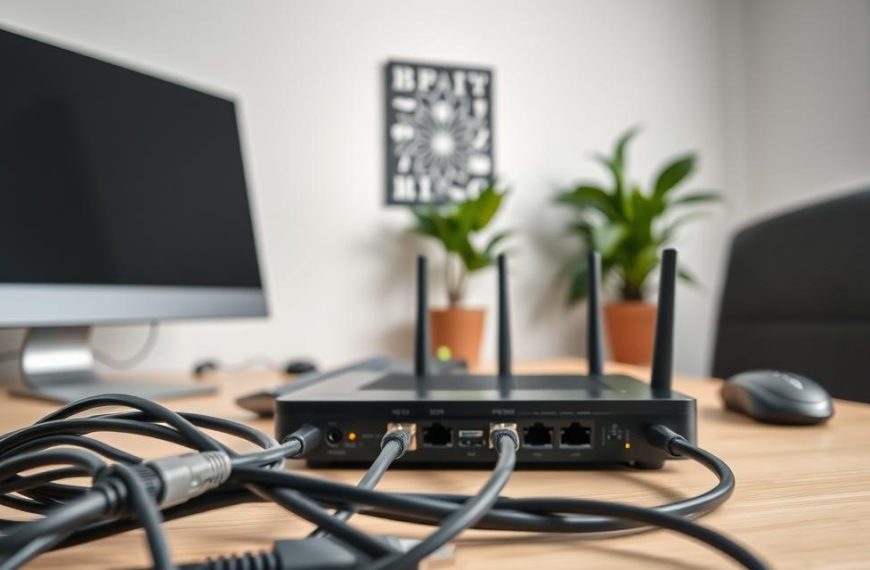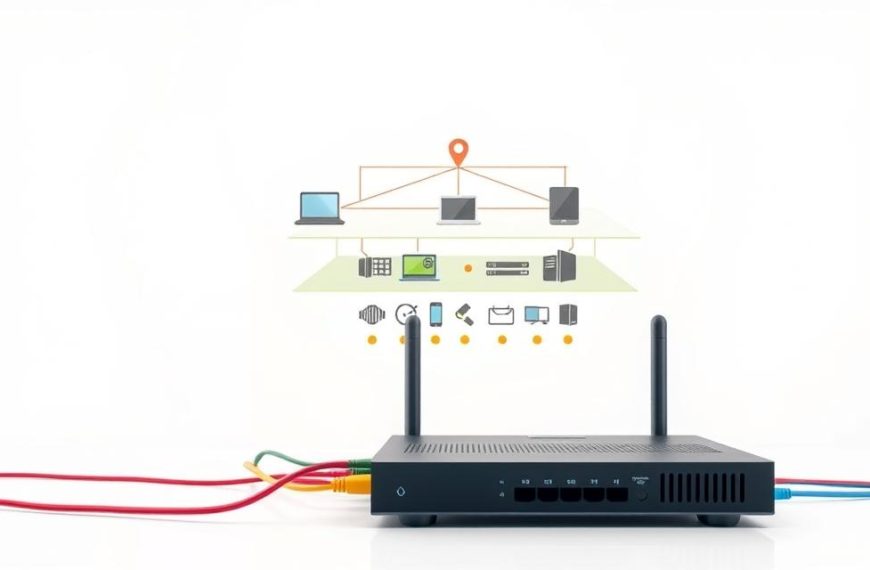Your Dell computer’s network security key is the password for your wireless connection. It’s a key part of keeping your device safe on the internet.
This digital key is like a shield for your network. It makes sure your computer and router can talk to each other safely. This stops others from getting into your personal stuff.
The main job of this key is to use strong network encryption. This means your data gets mixed up so others can’t read it. It keeps your online life private from prying eyes.
Finding your Wi-Fi password is key when you add new devices or fix connection problems. Knowing about this important security feature helps you keep your digital world safe.
Understanding Network Security Keys and Their Purpose
Network security keys act as digital guards for your wireless connection. They keep your devices safe from unwanted access. These keys check who can join your network and keep all data safe.
Defining the Network Security Key Concept
A network security key is a strong password for your wireless network. It keeps your network safe from unwanted access. You can use passwords, digital certificates, or biometric data for this.
When you connect a device to Wi-Fi, the security key checks if you’re allowed. It also makes your data safe by scrambling it. This way, only those with the right key can read it.
Common Wireless Security Protocols Explained
Wireless networks use different security protocols to protect your data. These protocols have changed over time to stay safe.
WEP (Wired Equivalent Privacy) was the first wireless security protocol. But, it’s not safe anymore. Experts say not to use WEP today.
WPA (Wi-Fi Protected Access) was a better option than WEP. It used TKIP encryption, but it wasn’t perfect.
WPA2 became the top choice for wireless security for many years. It used AES encryption to keep networks safe. Most devices support WPA2 today.
WPA3 is the newest wireless security standard. It offers stronger encryption and better protection for open networks. WPA3 also makes it easier to connect devices without screens.
| Security Protocol | Encryption Method | Security Level | Recommended Use |
|---|---|---|---|
| WEP | RC4 | Very Weak | Not recommended |
| WPA | TKIP | Weak | Legacy systems only |
| WPA2 | AES | Strong | Standard protection |
| WPA3 | GCMP-256 | Very Strong | Maximum security |
Importance of Network Security for Dell Computers
Dell computer users need strong network security. These devices handle important personal and work data. They need to be safe from cyber threats.
Good security stops unwanted access to your Dell system. It keeps your online activities safe. Without it, your data could be stolen or used wrongly.
Today’s Dell computers have the latest security features. Using WPA2 or WPA3 keeps your device and data safe. This protects your online activities.
What Is the Network Security Key on a Dell Computer: Retrieval Methods
Forgetting your Wi-Fi password can be frustrating. Luckily, there are several ways to find it again. You can check physical devices, use your computer’s features, or special software tools.
Router-Based Retrieval Techniques
Your router is often the easiest place to find your password. Many routers have the default password printed on them.
Look for a sticker on the back or bottom of your router. It should have:
- Network name (SSID)
- Default security key
- Router login credentials
If the password has been changed, you’ll need to log into your router’s admin panel. This lets you see or change your wireless settings.
- Connect your Dell computer to the router via Ethernet or Wi-Fi
- Open a web browser and enter your router’s IP address
- Log in using your administrator credentials
- Navigate to the wireless security section
Windows Operating System Solutions
Windows has tools to show passwords for networks you’ve connected to before. This works if your device is connected or has saved the network details.
In the Windows network settings, you can:
- View properties of saved networks
- Reveal the security key in plain text
- Manage multiple network profiles
This method doesn’t need extra software and keeps your system safe. The steps might vary slightly between Windows versions. But, it’s always accessible through the network and sharing centre.
Third-Party Software Options
There are many software apps that can find Wi-Fi passwords on your Dell computer. These apps scan your system for saved network details and show them in an easy-to-read format.
Some popular apps include:
- WirelessKeyView
- WiFi Password Revealer
- Magical Jelly Bean WiFi Password Revealer
While these apps are handy, be careful when using them. Only get software from trusted sources to avoid malware or security risks.
These tools work by accessing the same stored credentials as Windows. They present them in a simpler way, without needing to know a lot about your system.
Step-by-Step Instructions for Locating Your Wi-Fi Password
Finding your network security key is easy when you follow these steps. We’ve got three methods for different levels of comfort and tech skills.
Method 1: Accessing Your Router’s Administration Panel
This method lets you directly access your network’s security settings through your router’s interface.
Establishing Connection to Your Router
First, make sure your Dell computer is connected to your router. Use an Ethernet cable or Wi-Fi. Open a web browser and type your router’s IP address into the address bar.
Common router addresses are 192.168.1.1 or 192.168.0.1. You’ll need admin credentials, which are usually on your router’s label or in its manual.
Navigating to Wireless Security Settings
After logging in, find the wireless or Wi-Fi settings section. Router brands arrange their menus differently. Look for “Wireless,” “Security,” or “Network Settings.”
These settings might be under advanced options, depending on your router. The security settings have your network’s details.
Locating and Recording the Security Key
In the wireless security section, look for “Network Key,” “Security Key,” or “Passphrase.” This field shows your Wi-Fi password in plain text.
Write down this information safely. You can also change your password here, but you’ll need to reconnect all devices.
Method 2: Using Windows Network Settings
Windows has tools to show saved network credentials without going to your router.
Accessing Network and Sharing Centre
Click the network icon in your system tray and select “Network & Internet settings.” Or right-click the Start button and choose “Network Connections.”
Go to “Network and Sharing Center” from the control panel or settings menu. It manages all your network connections and properties.
Viewing Wireless Network Properties
In Network and Sharing Center, click on your active Wi-Fi connection name. Then, select “Wireless Properties” from the status window that appears.
This opens a dialogue box with your wireless network’s details. The security tab has the information you need.
Revealing the Security Key
In Wireless Network Properties, go to the “Security” tab. Check the box labelled “Show characters” to see your hidden Wi-Fi password.
You might need admin rights to see this. The password will be in the network security key field, ready to copy or note down.
Method 3: Command Prompt Techniques
For those who are tech-savvy, the command prompt offers powerful ways to retrieve information.
Basic Netsh Commands for Wi-Fi Information
Open Command Prompt as admin by searching “cmd” in Start and selecting “Run as administrator.” Type netsh wlan show profiles and press Enter.
This command lists all Wi-Fi networks saved on your Dell computer. Find your network name from the list for the next step.
Advanced Command Line Retrieval
To see a specific network’s details, type netsh wlan show profile name="YourNetworkName" key=clear. Replace “YourNetworkName” with your actual network SSID.
Scroll through the results to find the “Key Content” field under Security Settings. This shows your network security key in clear text.
The command prompt method works even when you’re not connected to the network. It’s great for troubleshooting.
Troubleshooting and Security Best Practices
Even with the right methods, you might face challenges with your network security key. This section covers common problems and gives key security tips. These will help keep your Dell computer and Wi-Fi network safe.
Common Issues When Retrieving Security Keys
When trying to access your Wi-Fi password, you might hit a few bumps. The most common problem is the “network security key mismatch” error. This usually means you’ve typed the password wrong.
Other issues include outdated wireless drivers, security protocols that don’t match, or problems with your router’s setup. Always check for typing mistakes first. This often solves the problem.
Dell’s support resources offer detailed help for troubleshooting wireless networking issues. They have specific advice for their hardware.
Resetting Your Network Security Key
If you can’t get your security key, you might need to reset it. To do this, you need to get into your router’s admin panel through a web browser.
Here’s how to reset your Wi-Fi password:
- First, connect directly to your router with an Ethernet cable.
- Then, enter your router’s IP address in your browser.
- Log in with your admin credentials.
- Go to the wireless security settings.
- Make a new, strong password.
- Save the changes and reconnect all devices.
Remember, resetting will cut off all devices. They’ll need to reconnect with the new password.
Security Considerations for Dell Computer Users
Keeping your Dell Wi-Fi secure is more than just getting your password right. Your network security key is your first defence against hackers.
Here are some key security tips:
- Make passwords strong with letters, numbers, and symbols.
- Avoid using personal info or common words.
- Change your Wi-Fi password every 3-6 months.
- Never use the same password for different networks or accounts.
Following these steps will greatly reduce the risk of security breaches. It will keep your sensitive info safe.
Protecting Your Wi-Fi Network from Unauthorised Access
There’s more to keeping your network safe than just password management. A multi-layered approach is best for your Dell system.
Consider these advanced security steps:
| Security Feature | Description | Benefit |
|---|---|---|
| WPA3 Encryption | Latest wireless security protocol | Strongest available protection |
| MAC Address Filtering | Restricts access to specific devices | Prevents unknown devices from connecting |
| Network Segmentation | Creates separate guest network | Isolates visitors from main devices |
| Regular Firmware Updates | Keeps router software current | Patches security vulnerabilities |
Keep an eye on connected devices and turn on your firewall. These steps will make your network safer. They ensure your Dell computer is in a secure wireless space.
By tackling security key issues and following these tips, you can build a strong defence for your network. Always choose security measures that fit your needs and comfort level.
Conclusion
Your network security key is the main defence for your Dell computer’s wireless access. It stops unwanted connections to your home network. Keeping this key safe is key to digital security.
There are many ways to find your Wi-Fi password when you need it. You can check your router’s admin panel, use Windows network settings, or try command prompt. Each method is a reliable way to get your security details.
Modern security like WPA3 offers better protection for wireless networks. If your router supports it, switching to WPA3 boosts your defence against cyber threats. This top-notch encryption is the latest standard in wireless security.
Good password management is vital for network safety. Always update your security key and use strong, unique passwords. This protects your Dell computer and other devices. Being alert to security risks keeps your digital world safe.
By following these steps, you build a strong security system for your home network. Your wireless connection stays safe when you focus on key management and keep up with new security standards.













